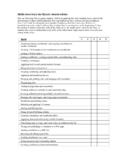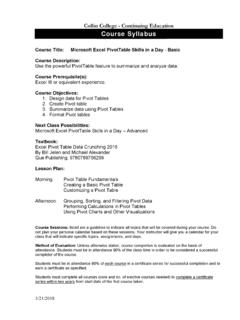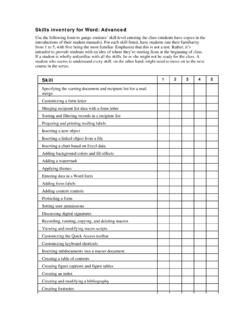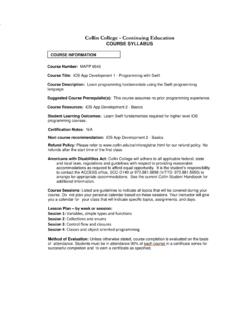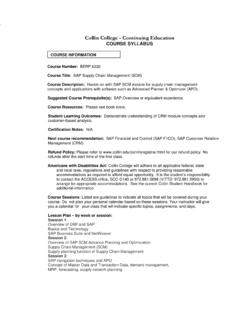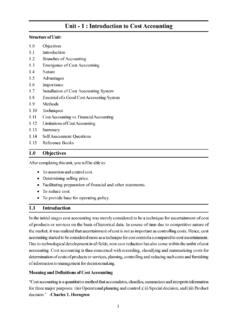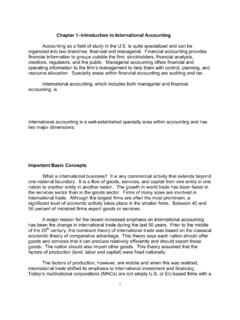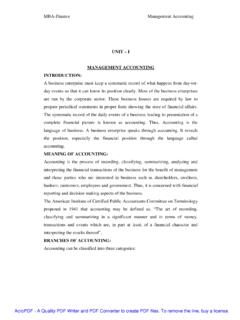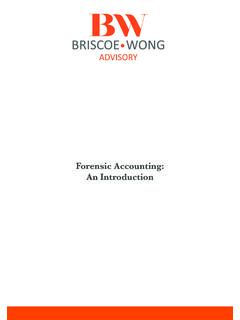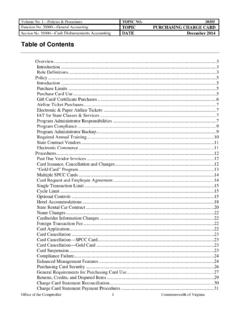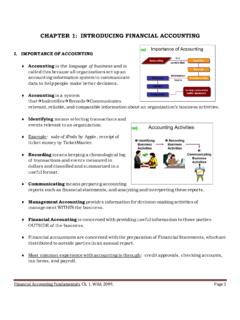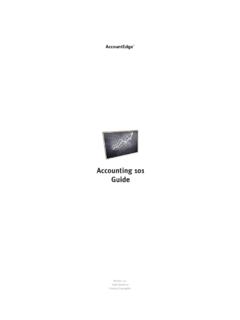Transcription of INTRODUCTION TO ACCOUNTING ACNT 1303 …
1 INTRODUCTION to ACCOUNTING I lecture Notes Page 1 of 20 INTRODUCTION TO ACCOUNTING ACNT 1303 lecture Notes GENERAL INFORMATION FOR COMPLETING THE CLASS The following is a summary of the twelve chapters that you will be completing this semester. Be sure that you are taking the time to read and STUDY each chapter. It is important to go through each of the examples in the book and to complete the Review Quiz. Spending time reading and understanding before you start the homework assignment will help you to complete in the exercises and case problems with more understanding. Please ask questions to clarify questions that you may have on any assignment or concept. Be sure to check your answers in the notebooks before turning in your assignments.
2 There are PowerPoint slides on the I drive that you may want to review before taking your exams or as reinforcement to your reading. Chapter 1 The Nature of ACCOUNTING ACCOUNTING is the process of recording, summarizing, analyzing, and interpreting financial (money-related) activities to permit individuals and organizations to make informed judgments and decisions. By law all businesses must keep ACCOUNTING records. Decisions are based on ACCOUNTING information for profit and non-profit companies alike. There are different forms of business organizations: o Private business object is to earn a profit o Sole Proprietorship owned by one person o Partnership co-owned by two or more persons o Corporation owned by investors called stockholders (The business not the owners are responsible for the company s obligations.)
3 There are different types of business organizations: Service business doctors, lawyers, barber shop, etc. Merchandising business purchases goods for resale Manufacturing business produces a product to sell THE ELEMENTS OF ACCOUNTING ASSETS Assets are items with money value that are owned by a business. Some examples are: cash, accounts receivable (selling goods or services on credit), equipment (office, store, delivery, etc.), and supplies (office, store, delivery, etc.). LIABILITIES Liabilities are debts owed by the business. Paying cash is often not possible or convenient, so businesses purchase goods and services on credit. The name of the account used is Accounts Payable. Another type of liability is Notes Payable.
4 This is a formal written promise to pay a specific amount of money at a definite future date. OWNER S EQUITY The difference between Assets and Liabilities is Owner s Equity. The can also be called capital, proprietorship, or net worth. INTRODUCTION to ACCOUNTING I lecture Notes Page 2 of 20 THE ACCOUNTING EQUATION (Study the examples in the book, p. 5) Assets = Liabilities + Owner s Equity This equation must always balance! BUSINESS TRANSACTIONS AND THE ACCOUNTING EQUATION A transaction is any activity that changes the value of a firm s assets, liabilities, or owner s equity. Each transaction has a dual effect on the basic ACCOUNTING elements. A transaction may affect more than two accounts in a transaction. This is called a combined entry.
5 Withdrawal (Drawing) is the removal of business assets for personal use by the owner. This transaction decreases the asset taken and the value of the business. Each transaction increases or decreases (or both) the basic elements in the ACCOUNTING equation. The effect of recording a business transaction must always leave the two sides of the ACCOUNTING equation in balance. To understand how a transaction affects the ACCOUNTING equation, go through each of the examples in the textbook. Be sure to pay attention to the Notes and Cautions that are given. FINANCIAL STATEMENTS Summaries of financial activities are called financial statements which are prepared on a regular basis at the end of an ACCOUNTING period. The ACCOUNTING period typically is one year; however, it can be any length of time for which records are maintained.
6 Usually the minimum is one month and the maximum length of time is one year for financial statements. There are several financial statements. You are going to prepare the Income Statement, Statement of Owner s Equity, and Balance Sheet. These must be completed in that order. Notice the page in your book that shows the three statements and how the information goes from one source to another. It is very important to always check your numbers since an incorrect number will affect more than one statement. Income Statement. This is a summary of a business s revenue and expenses for a specific period of time. It ONLY shows revenue and expenses. These should be listed in order from largest to smallest. (This should be done in this chapter because accounts are not given account numbers.)
7 Net Income is realized when revenue exceeds expenses. Net loss is realized when expenses exceed revenue. Statement of Owner s Equity. This is a summary of the changes that have occurred in the owner s equity during a specific period of time. This statement will show either an increase or decrease in the capital account. Balance Sheet. This statement is a listing of the firm s assets, liabilities, and owner s equity at a specific point in time. Total Assets must equal the addition of Liabilities and Owner s Equity. NOTE: Be sure that you are looking carefully at the examples given in the book when completing your assignments. You must write legibly and use a ruler to draw the lines. Notice that there are double rules to show that items have balanced.
8 Be sure to read and study the Summary and Key Terms at the end of each chapter. Chapter 2 Recording Business Transactions NOTE: It is important that you read the chapter and work through the problems and examples as given in the text. Reading, doing, and checking your answers will allow you to understand. Read each transaction given and see which accounts are affected. There will always be at least two. I am going to summarize the INTRODUCTION to ACCOUNTING I lecture Notes Page 3 of 20 chapter, but you need to spend quality time going through the exercises in order to apply the information to your assignment homework. ACCOUNT. An account is an individual record or form to record and summarize information for each asset, liability, or owner s equity transaction.
9 Each account will have a title and number. Debit means left side. Credit means right side. A T ACCOUNT is so named because it looks like a capital T. Use this form of an account to help you determine whether the amount is placed on the left (debit) or right (credit) side of the account. It is important that you think of debits and credits as only meaning left and right! Double-entry ACCOUNTING means that there will be at least two (2) accounts affected by each transaction. Debits and Credits can either be increases or decreases depending on the type of account. See chart on page 40. DEBITS MUST ALWAYS EQUAL CREDITS! Look at the example on page 42 to help you understand the Temporary Owner s Equity accounts.
10 All transactions that affect owner s equity could be recorded in one account, but it would be hard to determine profit and loss and would not be very practical. By putting expenses and drawing in separate, temporary debit accounts, and revenue and owner investments in separate, temporary credit accounts, it is easier to make decisions. These decisions can be easily obtained from these temporary accounts. At the end of the ACCOUNTING period these temporary accounts are closed into the capital account. They are only temporary used during the current ACCOUNTING period. Each ACCOUNTING period would have these accounts starting with a zero balance. Increases in Owner s Equity are investments and revenue. Decreases in Owner s Equity are withdrawals and expenses.
